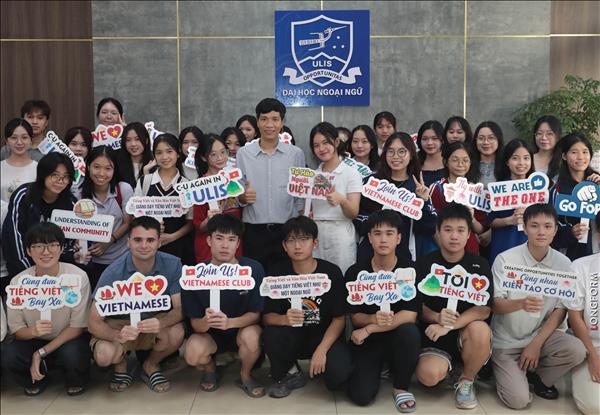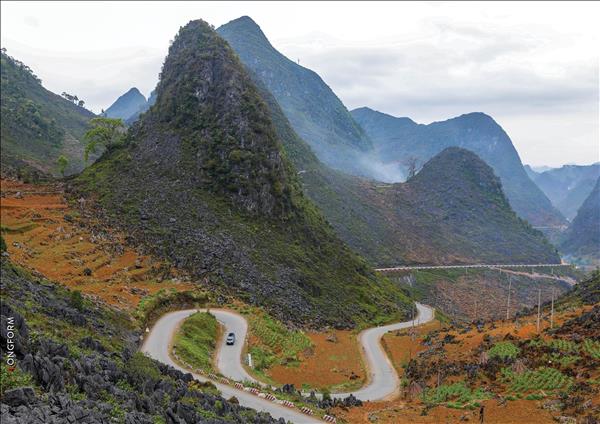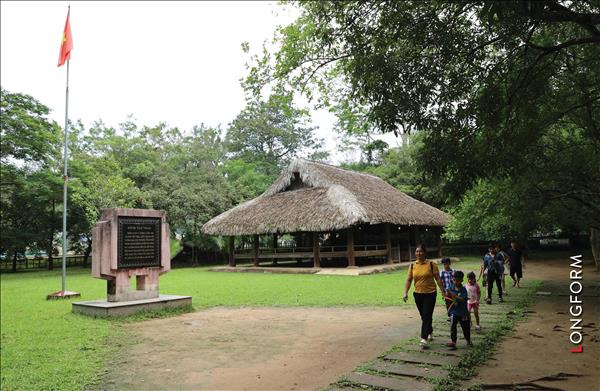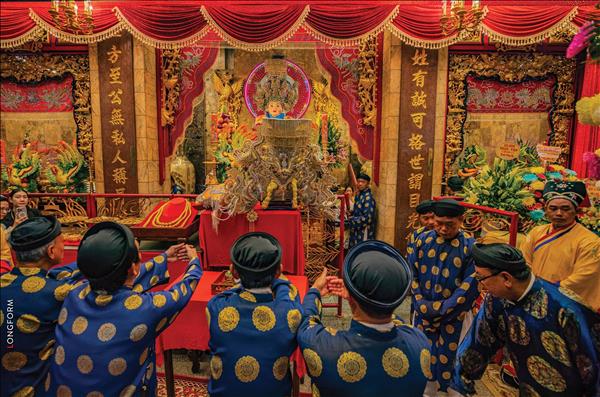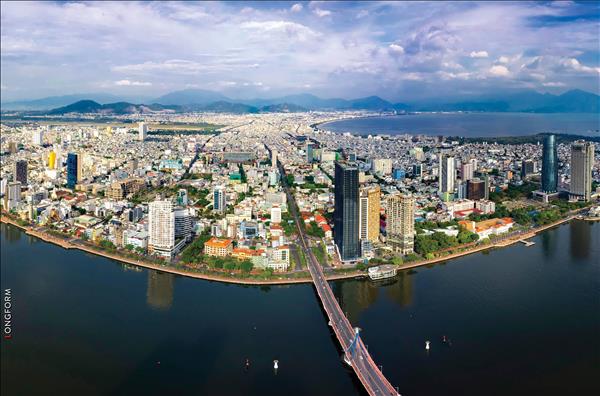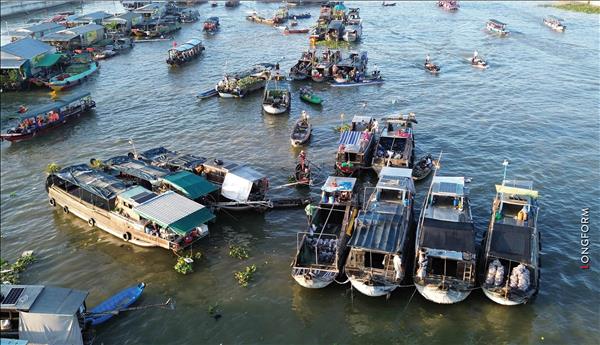Green countryside
Our first impression of Hai Hau is the greenery of some 350,000 trees which cover all the villages and roads, creating a peaceful atmosphere for this coastal district in Nam Dinh northern province.
Hai Hau is not only peaceful, but is also modern with a uniform system of roads, irrigation, electricity supply and waste treatment facilities. It also meets the needs for healthcare and education. All preschools, primary and lower secondary schools, and five out of seven upper secondary schools, reach national standards. The district hospital is furnished with state-of-the art equipment.
The district has 546 cultural centers in villages which are upgraded every two years. These village centers have all of the facilities and equipment for the arts, sports and other cultural activities.
We visited the cultural center of Bac Hai commune’s Village 4 where over 1,200 people from nearly 340 families live. The center is where old people exercise, young people play volley ball and badminton, and children practice martial arts in the morning. In the evening, villagers gather to read books, surf the internet and do other community activities.
Tran Xuan Bang, head of Village 4 said the library in his village’s cultural center has thousands of books and publications, attracting a lot of people. The village has set up its own website and Facebook group for villagers to update information about their community.
Vu Ngoc Truong, vice chairman of the People’s Committee of Hai Hau district said they pay great attention to cultural activities in order to preserve and promote local cultural values.
The development of Hai Hau is largely thanks to local people’s commitment to building their community. Of the 299 billion dong (roughly 23 million US dollars) invested in the infrastructure in Hai Hau in the last two years, contributions from the local people made up 17%.
“The residents readily support the local government in building a new-style rural area here”, Mai Quang Dinh from Yen Dinh township said. He added that people are willing to make financial contributions to building their homeland to make it beautiful.
Economic development
Hai Hau has the advantage of being in the coastal plain. The district is not only a large rice-growing area but also has developed animal breeding, fishing, medicinal tree growing, traditional craft and services.
Hai Hau fragrant rice is known nationwide. With five-hectare or larger rice fields with a yield of 10.7 tons/hectare, the district is a potentially big rice exporter. Many farmers make decent profits from intensive farming of high quality rice.
Shrimp-farming families in Phuc Hai commune, Hai Hau’s largest aquaculture area with around 300 hectares, earn between 500 million dong and 1 billion dong (roughly 434,000 US dollars) per crop. Fishermen in the coastal communes of Hai Dong, Hai Ly, Hai Chinh and Hai Trieu, and Thinh Long township can monthly make 30 to 50 million dong from fishing.
Many farmers in Hai Hau also earn a good income from growing medicinal trees. Bui Van Sam is a big material supplier of Traphaco, a leading producer of traditional medicines. After three years growing about three hectares of Polyscias fruticosa, a valuable medicinal material, Sam earns about 1.35 billion dong/hectare.
Hai Hau also has industrial centers which attract a lot of investors, including the Song Hong (Red River) Garment Company, Hai Ha Smart Shirt Company, Hai Duong Garment Company, sport shoes maker Viet Power, and Hai Thanh MSL Electronics Company. These industrial centers generate over 12,000 jobs for locals.
The district has also developed traditional crafts, including making fish sauce, wood art, and bonsai and medicinal tree growing. Hai Hau has 45 cooperatives in agricultural, fishing and environmental services, animal breeding, aquaculture, and safe farm and aquatic production. Members of these cooperatives on average earn between four and six million dong each month.
Story: Bich Van - Photos: Thanh Giang & Files
Our first impression of Hai Hau is the greenery of some 350,000 trees which cover all the villages and roads, creating a peaceful atmosphere for this coastal district in Nam Dinh northern province.
Hai Hau is not only peaceful, but is also modern with a uniform system of roads, irrigation, electricity supply and waste treatment facilities. It also meets the needs for healthcare and education. All preschools, primary and lower secondary schools, and five out of seven upper secondary schools, reach national standards. The district hospital is furnished with state-of-the art equipment.
|
The green and beautiful countryside of Hai Hau. Locals contribute nearly 20 billion dong to build the electricity network in Hai Hau. Built in 1509, the tiled roof bridge Cho Luong in An Hai commune, retains its old-time beauty. The martyr temple shows Hai Hau people’s gratitude to the nation’s fallen heroes. Hai Hau has 454 km of roads with flowers along the two sides. A stilt walking performance by Hai Ly fishermen at a sports event in Hai Hau. Photo: Files Exercising at the Elderly’s Physical Training Club in Village 4, Hai Bac commune. The well-equipped playground of a preschool in Hai Hau. The dialysis and artificial kidney ward of the district hospital is furnished with state-of-the art equipment. A class at Hai Hau A high school. |
The district has 546 cultural centers in villages which are upgraded every two years. These village centers have all of the facilities and equipment for the arts, sports and other cultural activities.
| On June 23, 2015, the Prime Minister issued Decision No. 921./QD-TTg recognizing Hai Hau as a standard new-style rural area. |
Tran Xuan Bang, head of Village 4 said the library in his village’s cultural center has thousands of books and publications, attracting a lot of people. The village has set up its own website and Facebook group for villagers to update information about their community.
Vu Ngoc Truong, vice chairman of the People’s Committee of Hai Hau district said they pay great attention to cultural activities in order to preserve and promote local cultural values.
The development of Hai Hau is largely thanks to local people’s commitment to building their community. Of the 299 billion dong (roughly 23 million US dollars) invested in the infrastructure in Hai Hau in the last two years, contributions from the local people made up 17%.
“The residents readily support the local government in building a new-style rural area here”, Mai Quang Dinh from Yen Dinh township said. He added that people are willing to make financial contributions to building their homeland to make it beautiful.
Economic development
Under our strategy for building Hai Hau into a new-style rural area, the district is set to have all of its villages reached the standards for a ‘bright, green, clean and beautiful’ rural area. It must also meet the three criteria of ‘a solid, synchronous and connected rural infrastructure’, ‘a green and clean rural infrastructure’, and ‘a decent cultural lifestyle’. Pham Van Chien, chairman of the People’s Committee of Hai Hau district |
Hai Hau fragrant rice is known nationwide. With five-hectare or larger rice fields with a yield of 10.7 tons/hectare, the district is a potentially big rice exporter. Many farmers make decent profits from intensive farming of high quality rice.
Shrimp-farming families in Phuc Hai commune, Hai Hau’s largest aquaculture area with around 300 hectares, earn between 500 million dong and 1 billion dong (roughly 434,000 US dollars) per crop. Fishermen in the coastal communes of Hai Dong, Hai Ly, Hai Chinh and Hai Trieu, and Thinh Long township can monthly make 30 to 50 million dong from fishing.
|
Fishing is an advantage for the local economy. Nguyen Van Chinh and his grandchild Bui Tien Manh, who are members of Dong Hai cooperative in Dong Hai commune, are about to transport salt to the cooperative’s storage place. Ninh Co is a well-know fish sauce brand from Hai Hau. Hai Phuc commune has 300ha of brackish water shrimp farming. Fishing boats return home. |
Many farmers in Hai Hau also earn a good income from growing medicinal trees. Bui Van Sam is a big material supplier of Traphaco, a leading producer of traditional medicines. After three years growing about three hectares of Polyscias fruticosa, a valuable medicinal material, Sam earns about 1.35 billion dong/hectare.
Hai Hau also has industrial centers which attract a lot of investors, including the Song Hong (Red River) Garment Company, Hai Ha Smart Shirt Company, Hai Duong Garment Company, sport shoes maker Viet Power, and Hai Thanh MSL Electronics Company. These industrial centers generate over 12,000 jobs for locals.
|
Hai Hau is a large rice grower in Vietnam with a yield of 10.6 tons/ha/crop. Song Hong (Red River) Garment Company generates 2,200 jobs for locals in Hai Hau. A sophisticated nacre-inlaid product shows the deftness of artisans in Hai Minh commune. Farms raising egg-laying ducks are popular in Hai Thanh commune. |
The district has also developed traditional crafts, including making fish sauce, wood art, and bonsai and medicinal tree growing. Hai Hau has 45 cooperatives in agricultural, fishing and environmental services, animal breeding, aquaculture, and safe farm and aquatic production. Members of these cooperatives on average earn between four and six million dong each month.
|
-The annual economic growth in Hai Hau has reached 7.22%. In 2017, the total revenue of the district reached nearly 256.5 billion dong. The income per capita was 40 million dong. The rate of poor households was only 2%. -The national target program on building new-style rural areas is an overall socio-economic development and political, security and national defense program adopted and implemented nationwide by the Vietnamese Government. Under this national target program of the 2010-2020 period approved by the Prime Minister, the country is set to have 50% of its communes reached the standards on a new-style rural area according to the national set of criteria of new-style rural areas. |
Story: Bich Van - Photos: Thanh Giang & Files

